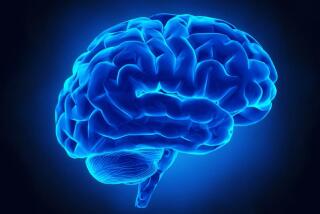Fighters’ brains damaged long before symptoms emerge, study hints
- Share via
A yearlong study of boxers’ and mixed martial-arts fighters’ brain activity has found those who fight for more than six years begin to experience damage and those who fight longer than 12 years expose themselves to an even greater decline each time they return to the ring.
“What we’ve found suggests changes and damage in the brain happens years before symptoms emerge,” said Dr. Charles Bernick, author of the study. “It’s what we see in Alzheimer’s and Parkinson’s patients.”
Bernick has supervised MRIs and computerized and cognitive tests of an estimated 170 fighters at the Cleveland Clinic’s Las Vegas center in the past year. He will present his findings to the American Academy of Neurology this week in New Orleans.
“If we’re going to protect these athletes, we need to follow them earlier in their course,” Bernick said.
Currently, fighters are required to undergo only one brain MRI test, which could be taken at the beginning of their career. State commissions can request an additional MRI if they’re alarmed by a fighter’s age, performance or behavior. But pinpointing when to stop a fight remains an undefined point of discretion.
With his research, Bernick was hoping to help establish the threshold neurologists can use to determine the start of chronic traumatic encephalopathy (CTE), a degenerative brain disease.
CTE emerges in those who suffer multiple concussions and other brain damage that comes with being punched in the head. Symptoms of CTE include memory loss, aggression and difficulty thinking.
Bernick said the study found fighters begin losing brain volume — as brain cells die — after six years of fighting.
Fighters who commit to the Cleveland Clinic program get free MRI tests, but must agree to return annually for monitoring.
“We still need to follow these guys over time,” Bernick said. “If someone’s having damage, a commission might want to limit the number of fights he has. There is a hierarchy of protective things, interventions to help. This is still being sorted out.
“We are looking at this ‘threshold effect.’ How much punishment can a brain take? What are the markers we can see for long-term problems?”
The study received a $12-million boost in funding earlier this year from a Las Vegas dinner and auction. One of the highlights of the night was Ultimate Fighting Championship Chairman Lorenzo Fertitta outbidding Dallas Cowboys owner Jerry Jones, spending $1.1 million for a pair of autographed gloves belonging to Muhammad Ali.
twitter.com/latimespugmire
More to Read
Go beyond the scoreboard
Get the latest on L.A.'s teams in the daily Sports Report newsletter.
You may occasionally receive promotional content from the Los Angeles Times.










